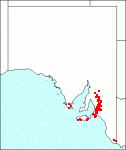Family: Fabaceae
Acacia retinodes
Citation:
D. Schlechtendal, Linnaea 20:664 (1847).
Derivation: retinodes--rhetinodes (Gr.)--resinous, refers to the gum-yielding properties. Synonymy: Not Applicable Common name: Swamp wattle, Silver wattle
Description:
Tall, glabrous shrubs or small trees to 8 m high; branches ascending, often drooping towards the ends, canopy medium to dense, dull bluish-green, rounded or somewhat pyramidal in shape; branchlets reddish-brown, acutely angled and later becoming smooth, greyish and almost terete except for the striate ridges continued below the phyllodes.
Phyllodes linear-lanceolate to oblanceolate, 3-20 cm long, 3-15 mm broad, usually broadest above the centre and tapering gradually towards the base, straight or slightly curved, never falcate, thin, glabrous, dull-green to glaucous, mid-vein prominent, lateral veins numerous, rather obscure, margins pale vein-like, apex acute or obtuse with a small straight or uncinate point. Glands small, on upper margin near base of the phyllode.
Inflorescences racemose, much shorter than phyllodes, consisting of 6-15 heads, sometimes appearing paniculate towards the ends of the branches; flower-heads pale yellow, c. 20-40-flowered; peduncles glabrous, slender; flowers 5-merous.
Legumes shortly stipitate, linear, 3-14 cm long, 6-8 mm broad, usually straight, chartaceous, brown, margins not or only slightly constricted between the seeds. Seeds longitudinal in legume, obloid; funicle reddish-brown, encircling the seed in a double fold and thickening into a whitish aril.
Var. retinodes. Phyllodes 8-20 cm long, 5-15 mm broad, often glaucous, apex short; straight or slightly curved flower heads usually 30-40-flowered; legumes 6-14 cm long, straight-edged.
|
|
Distribution:
|
Eyre Peninsula (southern part), Northern and Southern Lofty, Murray (around Monarto) and Kangaroo Island regions. In the Mount Lofty Ranges, found growing in damp gullies along creeks and grassy hillsides in open forest, associated with Eucalyptus obliqua, E. baxteri, E. leucoxylon and E. viminalis. Soils: mainly hard alkaline red duplex, hard acid or sandy alkaline yellow duplex and grey-brown calcareous loamy earths. Rainfall 400-1 000 mm. Also Vic. and Tas.
In South Australia two variants of A. retinodes var. retinodes can be recognised. The first is a form in swamps and wet sites that has broader more glaucous leaves and a smooth trunk. The second is found on drier sites, slopes above creeks and in more northerly parts of its range that has narrow green leaves and a trunk that is finally almost black with a rough bark. These have not been given any taxonomic status.
The hill form has been observed and collected at Clare, Bethany, Penwortham, Marrabel, Tarnma Creek, near Ngapala along roadsides and at Brady Creek. It has not, for the time being, been mapped separately.
Var. uncifolia. J. M. Black, Trans. R. Soc. S. Aust. 56:42 (1932). Phyllodes 3-6 cm long, 4-6 mm broad, usually dull-green, apex always uncinate; flower-heads 20-25-flowered. Legumes 6-11 cm long, slightly constricted. Allied to A. quornensis.Southern Eyre Peninsula, Southern Lofty and Kangaroo Island regions. Also Vic.
|
Flowering time: Irregular periods throughout the year, but mainly summer months. Usually October — December. |

SA Distribution Map based
on current data relating to
specimens held in the
State Herbarium of South Australia
|
Biology:
No text
Related taxa:
A. rivalis, A. gillii, A. leiophylla, A. confluens, to which reference should be made for discussion.
Taxonomic notes:
Two coastal populations of A. retinodes var. uncifolia in Victoria are protogynous (i.e. female phase first) and highly self-incompatible, Bernhardt et al. (1984). The flowers are nectar-less but insects are attracted to the flowers by colour and fragrance (?pollen). Floral foragers represented three insect orders but observations and pollen load indicated that solitary bees of the Colletidae and Halictidae are the major pollen collectors. The method for removal of pollen from the anthers is via thoracic vibrations. During the female phase the flowers offer no pollen so that foraging by bees on such flowers is interpreted as a trend towards partial pollination by deceit. The visiting insects were most active in the morning.The reproductive biology of A. retinodes continues to be studied by Knox et al. (1989). The stigma is receptive from the time the flower opens (female phase) and declines the second day (male phase). Stigma receptivity is associated with a stigma exudate and generally lasts a single morning. By the afternoon the flower heads have usually entered the male phase. The exudate comprises proteins, carbohydrates and lipids. No fewer than 75 insects were collected by Bernhardt & Walker (1985) foraging on the flowers of A. retinodes var. retinodes in Victoria. Eighty per cent of the insects (82% of the bees) carried pollen of at least one other local plant. There was greater taxonomic diversity of bees on var. retinodes than had been recorded on var. uncifolia and also a higher rate of generalist foraging. There are few records of mistletoes on A. retinodes but 4 collections of Amyema preissii, wire-leaved mistletoe and a single one of Lysiana exocarpi have been made. The leaves of A. retinodes can be used to dye wool a yellow to fawn colour with an alum mordant, Martin (1974). A. retinodes is recorded as being locally established in South-East Europe and occasionally established in California.
Cultivation:
An attractive species for ornamental planting; well known and has been in cultivation for many years. Very fast growing, suitable for roadside planting in cool districts.
Author:
Not yet available
Source:
|

